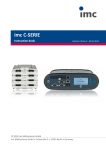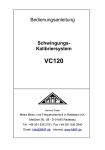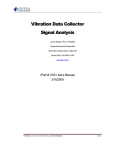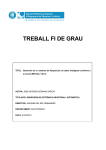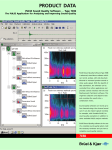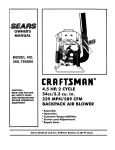Download MMF POS M68 Series Instruction manual
Transcript
Instruction Manual Charge Amplifiers M68 Series Manfred Weber Metra Mess- und Frequenztechnik in Radebeul e.K. Meissner Str. 58 - D-01445 Radebeul Phone +49-351-836 2191 Fax +49-351-836 2940 Email: [email protected] Internet: www.MMF.de The latest version of this document can be downloaded from: http://www.mmf.de/product_literature.htm © Manfred Weber Metra Mess- und Frequenztechnik in Radebeul e.K. Aug. 10 #162 Contents 1.Application................................................................................................................................5 2.Function and Operation.............................................................................................................5 3.Power Supply............................................................................................................................6 3.1.Grounding Concept............................................................................................................6 3.2.External Supply .................................................................................................................6 3.3.Battery Operation (M68D1)...............................................................................................7 4.Inputs........................................................................................................................................7 4.1.Charge Input ......................................................................................................................7 4.2.IEPE Input .........................................................................................................................7 4.2.1.Switching Off the IEPE Supply .................................................................................9 5.Avoiding Ground Loops............................................................................................................9 6.Amplifier ...............................................................................................................................10 7.Level Indicators.......................................................................................................................10 8.Low Pass Filter .......................................................................................................................11 9.High Pass Filter.......................................................................................................................12 10.Integrators.............................................................................................................................12 11.Rack Cases for Model M68R1..............................................................................................15 12.Technical Data......................................................................................................................16 Appendix: Limited Warranty Declaration of Conformity Figure 1: Front view of Model M68D1 with control elements 4 1. Application The Signal Conditioners of M68 series are intended for connection of piezoelectric acceleration, force or pressure transducers. The input is suitable for sensors with charge output as well as for IEPE compatible transducers or microphones. By means of the M68 the sensor signal can be best possibly adapted to the existing measuring equipment or PC-based data acquisition systems. The Signal Conditioners provide the following functions: • Adaptation of the sensor signal and sensor supply • Amplification • High- and low-pass filtering (for example anti-aliasing filter) • Integration of the sensor signal, for instance, to measure velocity or displacement. Models M68D1 and M68D3 are housed in a rugged aluminum case. Both models can be used in laboratory as well as under field conditions. Model M68D1 may also be operated from batteries. Model M68R1 has been developed for multichannel measuring systems. It fits into 19”-rack systems. 2. Function and Operation Figure 2 shows the block diagram of Model M68 with its most important functional groups. IEPE supply IEPE J1 (ICPon/off) Gain Frequency 0.1Hz a Gain 3Hz Input U Q/10 Q Q1 U Q/10 Q V1 High pass Low pass v d V2 1. Int. 2. Int. Q2 + Output V=1 Comparator >5% Comparator Overload Figure 2: Block diagram Depending on the position of the input switch, the input signal passes the impedance converter Q1 or Q2. If IEPE operation is selected, the signal is directly connected to the amplifier. At IEPE operation a constant current is fed into the input socket to supply the sensor electronics. The constant current source can be switched off by the internal jumper J1, in case an AC voltage shall be connected to the input. The input circuit is followed by the first amplifier stage, low pass and high pass filters. The low pass filter has 6 selectable limiting frequencies. The high pass filter has a limiting frequency of 3 Hz, which can be bypassed by the switch “HIGH PASS / INTEGRATOR”. In this case the full 5 bandwidth down to 0.1 Hz comes into effect. The filters are followed by the second amplifier stage. The divided gain before and after filtering provides sufficient dynamic range, even for signal components outside the filter range. At the same time a high signal-to-noise ratio is achie ved. Before reaching the output driver the signal may pass one or two integrating stages. The output is DC coupled. A control LED for the output modulation indicates an output signal higher than 5 % of full-scale modulation. An overload LED shows if the output signal exceeds 90 % of full-scale modulation. It also indicates overload before the filter stages. Models M68D1, M68D3, and M68R1 have identical electronic circuits. 3. Power Supply 3.1. Grounding Concept The inputs and outputs of the signal conditioners are single ended, i.e. asymmetrical. In case an additional signal ground connection is required, ground is available via a separate connector at the rear of the instruments. For the Models M68D1 and M68D3 this connector is a 4 mm banana jack. The signal ground of Model M68R1 can be found at the 4-pole frame connector. The case of the instruments is internally connected to ground. If model M68R1 is used with the rack cases M68B6 and M68B12 a connection is made between signal ground and protective earth potential via the case. The power supply is separated from signal ground. In some cases it may be of advantage to connect the minus pole of the power supply to signal ground, to avoid ground loops. For this purpose you can plug in the 4 mm jumper (delivered with the instruments) at the rear of Models M68D1 and M68D3. At Model M68R1 the terminals of the power supply socket can be connec ted by a wire. 3.2. External Supply The Signal Conditioners M68 are powered by an external DC voltage Models M68D1 and M68D3 come with a mains plug adapter for 115/230 VAC. The power supply socket according to DIN 45323 is located at the rear of the instruments. Any other voltage of 5 V to 15 V DC and about 300 mA (for M68D1) or 1 A (for M68D3) may be connected to this socket. The positive supply terminal is connected to center pin (tip). The POWER ON/OFF switch is located at the rear. The M68R1 also has its power supply connector at the rear. It is a 4-pole frame connector type WAGO 232. The pin designation is shown in Figure 3. + 5 .. 15 V 0V 0V Signal ground Figure 3: Power supply socket of Model M68R1 6 The supply voltage is connected to the terminals “+ 5 .. 15 V“ and “0 V”. A special plug with screwed contacts for the rear socket is delivered together with the instrument. This way the power supply can be wired manually. In case you use the offered 19”-mounting racks with internal power supply unit, this connection is realized by the backplane. Model M68R1 has no power on/off switch. The instruments are protected against false polarization and short-time excess voltage up to 60 V. All models of M68 series have an LED “BAT O.K.” indicating sufficient supply voltage. It lights up green, as long as the voltage is above 5 V. It works for battery operation as well as for external power supply (M68D1). 3.3. Battery Operation (M68D1) Model M68D1 has a battery compartment for four “AA” size batteries (type LR 6). It is opened by unscrewing four plastic knobs and removing the cover. The right polarity is shown on the battery holder. To ensure long battery life it is recommended to use alkaline batteries. Accumulators may be used as well. You can operate the instrument on NiMH or NiCd. However, by rea son of the lower voltage of accumulators, the battery control will not work exactly. Please take discharged batteries out of the instrument to avoid damage by leakage. Also, remove the batteries if the unit is not in use for a longer period. 4. Inputs The Signal Conditioners M68 are designed for both sensors with charge output and with inte grated impedance converters to IEPE standard as well. You can switch from one to the other type of transducer by means of the slide switch next to the input socket. Both input types use the same BNC input socket. 4.1. Charge Input Capacitive signal sources, usually piezoelectric sensors with charge output, are connected to the charge input (Q). The input is fed to an amplifier with capacitive feedback. All M68 instruments have two input stages for charge. In the position “Q/10” of the switch the gain is divided by 10. The advantage of charge measurement is, that cable capacitance and insulation resistance have almost no influence to the measuring result. For sensors with charge output it is strongly recommended to use special low-noise cables. Ordinary cable will cause a considerable measuring error at mechanical stress, as a result of the so-called triboelectrical effect. Cables with low insula tion resistance, for example caused by humid connectors, reduce the accuracy of measurement at lower frequencies. A desirable insulation resistance is higher than 10 GΩ. Cables longer than 10 m are not recommended at the charge input. 4.2. IEPE Input IEPE stands for "Integrated Electronics Piezo Electric". It has been established as industrial standard for piezoelectric transducers. Other brand names for the same principle are ICP ®, Isotron®, Deltatron®, Piezotron® etc. The integrated sensor circuit transforms the charge signal of the piezo-ceramics, with its very high impedance and high EMI sensitivity, into a voltage signal with low impedance. The converted signal can be easier transmitted. The cable length at this input may be more than one hundred meters. Ordinary low cost coaxial cable can be used. 7 A peculiarity of IEPE is, that power supply and measuring signal use the same line. So, an IEPE transducer needs, like a transducer with charge output, only one single-ended line. Figure 4 shows the circuit diagram. To separate the low impedance sensor signal from the power supply, the integrated circuit is supplied with constant current. This constant current must be fed into the measuring line and simultaneously separated from the following amplifier stages. The yellow LED “IEPE ON” indicates the flow of constant current. IEPE Transducer Signal Conditioner Us Integrated amplifier Piezo ceramics Q U coaxial cable, > 100 m I const CC CC I const Coupling capacitor RI U Input resistance s RI Constant supply current Supply voltage of constant current source Figure 4: IEPE principle By supplying the sensor with constant current a positive DC voltage arises over its terminals. This static bias voltage depends on manufacturer and specimen and amounts to about 5 through 14 V. The sensor signal is superposed on this bias voltage. The output voltage of the transducer never changes to negative values. Its minimum value is the saturation voltage of the integrated impedance converter (0.5 V to 1 V). The supply voltage of the constant current source determines the maximum value of the output voltage. For the M68 this voltage amounts up to 24 V and guarantees an optimum dynamic range for all available sensors.Figure 5 shows these relations. 8 Max. output voltage = supply voltage of constant current source positive overload 24 V Sensor bias voltage 5 .. 14 V (see data sheet) Min. output voltage = saturation voltage (see data sheet) 0.5..1 V 0V negative overload Figure 5: Dynamic range of IEPE compatible transducers 4.2.1. Switching Off the IEPE Supply In some cases it may be necessary to switch off the constant current supply, in order to use the input for normal AC sources. For this purpose, please change the position of the jumper, which you will find at Models M68D1 and M68R1 behind the front panel. Remove the cover of Model M68D1 by unscrewing the four plastic screw heads. To remove the cover of Model M68R1, four screws at the side and two at the back are unscrewed. Jumper J1 is located left at the front side of the printed circuit board. Plug it into the position “OFF” to switch off the constant cur rent source. After removing the front cover of Model M68D3 you will see only the jumper of channel 1. To reach the jumpers of channels 2 and 3, please remove front and rear panel. 5. Avoiding Ground Loops Earthing or ground loops are often the reason for measuring errors in multichannel measuring systems. In most cases you will find a superimposed 50 Hz or 100 Hz voltage on the measuring signal. One reason for this effect may be, that the transducers are connected to ground not only via their cable at the signal conditioner, but also in addition at the measuring point through their case. Vibration transducers are often mounted at grounded machine parts. Within earthing systems transient currents may appear. These transient currents cause a potential drop across the earthing or grounding wires. Via the signal input of the amplifier they may result in a considerable measuring error. To avoid this, insulated attachment of the transducers is recommended. Metra offers several industrial vibration transducers with insulated mounting base and different insulating flanges for non-insulated sensors. 9 A star-shaped grounding network is the ideal solution to avoid ground loops. Star-shaped means that all grounding wires of the sensors and the amplifier outputs are tied to ground at the signal conditioners, without any transverse connections. In many cases this is more difficult to realize for the outputs than for the inputs, because the following measuring equipment may have singleended, inputs. If you have the choice to use differential inputs, which can be found on many data acquisition boards, you should preferably use them. 6. Amplifier The instruments of M68 Series have the following measuring ranges: Charge mode: 0.1 / 1 / 10 / 100 / 1000 mV/pC IEPE mode: 1 / 10 / 100 / 1000 times The gain selection switch ”GAIN” has four positions. In position “Q/10” of the input selection slide switch the measuring range of all charge ranges is divided by 10. This may be advanta geous for measurement with high sensitivity transducers or for shock measurement. After connecting a sensor and occasionally after changing the measuring range, the amplifier needs a certain settling time because of a short term overload. Therefore it may take up to 30 s, until the output voltage is free of DC components. The amplifier output is buffered and DC-coupled. Therefore, possible offset currents fed into the amplifier output by the following equipment (for instance a PC data acquisition board), do not cause a DC offset. 7. Level Indicators LEDs indicate minimum modulation and overload condition. The LED “>5%” lights up at an output voltage higher than 0.7 V. The LED “OVL” lights up if the output voltage exceeds 9 V. The optimum gain range is selected, if the LED “>5%” lights up and the LED “OVL” remains dark. If both LEDs remain dark, the gain should be increased. If both LEDs light up the gain should be reduced. The overload detector monitors both the amplifier output and the filter input (see Figure 2). By that means overload condition will also be indicated when high signal components beyond the filter pass band occur. An overload detector at the integrator input is not provided. In some cases high level components at higher frequencies may overload the amplifier stage before the integrator while at the integrator output no overload condition can be detected. To avoid this, make sure to check the signal level in the switch position “ACC” (integrator off) before switching on the integrators. When the LED indicates overload you can use the low pass filter to attenuate high frequencies. 10 8. Low Pass Filter To eliminate disturbing noise or to comply with the Shannon theorem: “Signal frequency should be less than half of the sampling frequency”, it can be advantageous, to use a low pass filter. For higher accuracy in the time domain it is recommended to set the low pass at 1/10 the sampling frequency. The instruments of M68 series have 6 internal low pass filters. The scale at the positions of the filter switch “LOW PASS” is shows the 3 dB limiting frequencies in kHz. The following table shows the 3 dB and the 10 % limiting frequencies of the low pass filters: 3 dB Frequency 100 Hz 300 Hz 10 % Frequency 70 Hz 200 Hz 1 kHz 10 kHz 700 Hz 7 kHz 20 kHz 50 kHz 14 kHz 35 kHz The slope of the low pass filters is 40 dB per decade. 0 dB 50 kHz 180° 90° 1 kHz 10 kHz 20 kHz 0 -20 dB -90° -40 dB 0,1 1 kHz 10 -180° 0,1 100 0 dB 50 kHz 20 kHz 10 kHz 1 kHz 1 kHz 10 100 180° 90° 100 Hz 300 Hz 0 -20 dB -90° 300 Hz 100 Hz -40 dB 10 100 Hz 1000 10000 -180° 10 100 Figure 6: Typical frequency and phase response of the low pass filters 11 Hz 1000 10000 9. High Pass Filter The M68 signal conditioners have a high pass filter with a lower limiting frequency of 3 Hz (3 dB). By means of this filter low frequency noise can be removed. Low frequency noise may occur, for example, by the influence of temperature transients to piezoelectric compression type accelerometers. The slope of the 3 Hz high pass filter is 40 dB / frequency decade. The 3 Hz high-pass filter is switched on by turning the “INTEGRATOR HIGH PASS” switch into positi on “ACC 3 Hz”. If the high pass filter is switched off (switch position “0.1 Hz ACC”), the lower limiting frequency of the amplifier is 0.1 Hz. With the integrators the high pass filter is always switched on. 180° 0 dB 90° 0 -20 dB -90° -40 dB 0,1 -180° 1 Hz 10 100 0,1 1 Hz 10 100 Figure 7: Frequency and phase response of the high pass filter As the filters are located between the amplifier stages (see Figure 2) the instrument does not become overloaded, even if the measured signal has higher spectral components outside the filter range. 10. Integrators The M68 can integrate the measuring signal one or two times. Integration can be useful for vi bration measurement by means of accelerometers on rotating machinery. Single integration of vibration acceleration results in velocity, double integration in displacement. The „INTEGRATOR HIGH PASS“ switch activates the integrators. In position “ACC“ (acceleration) the measuring signal passes without integration. At the position “VEL” (velocity) the signal is integrated once, in position “DISP” (displacement) twice. With switched on integrators the 3 Hz high pass filter is always activated. The following calculations show how the M68 output uout corresponds to the three vibration quantities. The selected gain range of the M68 is G and the accelerometer sensitivity (see transducer data sheet) is Bua. 12 Vibration acceleration a (without integration): a= uout G⋅Bua (a in m/s²; uout in mV; G in mV/mV; Bua in mV/ms-2) Vibration velocity v (single integration): v= uout ⋅10 G⋅Bua (v in mm/s; uout in mV; G in mV/mV; Bua in mV/ms-2) Vibration displacement d (double integration): d= u out ⋅100 G⋅Bua (d in µm; uout in mV; G in mV/mV; Bua in mV/ms-2) The equations above apply for IEPE compatible accelerometers. For accelerometers with charge output, G is replaced by the selected charge amplifier range in pC/g and B ua is replaced by the transducer’s charge sensitivity Bqa. Example: Vibration velocity is measured using an accelerometer with a sensitivity of B qa= 5 pC/ms-2. The M68 is operated in the range G=100 mV/pC. Its output voltage is 300 mVrms. What is the corresponding vibration velocity? Solution: v= 300 ⋅10=6 mm/ s RMS 100⋅5 Often a direct connection between the output voltage of the M68 and the measured physical quantity (for example “1 mV corresponds to 1 mm/s”) is desired. This can be achieved by adjusting the connected measuring equipment or by typing in a correction factor in a PC based data acquisition system. In the example given above this correction factor would be 0.02. At higher frequencies the output voltage will have only small amplitudes after integration. The dynamic range and the signal-to-noise ratio therefore become lower in the kHz-range (Figure 8). 13 dB 20 Max. modulation % Modulation limits Sin gle 0 100 int eg rat i l ub Do on e 10 n io at gr te in -20 -40 1 0.1 1 10 Hz 100 1000 Figure 8: Frequency response of the integrators 180° 90° 0 -90° -180° 0.1 1 10 100 1000 Figure 9: Pase response of the integrators In some cases signal components with high frequency and magnitude may overload the amplifier although no overload can be detected at the M68 output. The overload LED remains dark. This can occur due to the attenuation of higher frequencies by the integrator (compare Figure 8). To avoid possible overload, make sure to check the signal level in the switch position “ACC” (integrator off) before using the integrator. If an overload condition should be indicated, reduce high frequency components by an appropriate low pass frequency. 14 11. Rack Cases for Model M68R1 For the 19” unit M68R1 the following rack mounting cases are available: Model M68B6 M68B12 Channels 6 12 Built-in power supply yes yes Figure 10: Front view of rack case M68B12 Figure 11: Rear view of rack case Model M68B6 The rack cases Models M68B6 and M68B12 supply the plugged-in modules via a backplane. They can be operated with both 115 VAC and 230 VAC without changing any settings. 15 The fuse holder of the rack cases M68B6 and M68B12 with mains power supply is located inside the mains socket at the rear. It can be pulled out using a screw driver. The fuse facing to the back of the drawer is a spare fuse. The rear one is the mains fuse. Important: Unplug the device from the mains voltage before replacing the fuse. Make sure that the fuse to be replaced has the rating T 800 mA. 12. Technical Data Measuring inputs Charge and IEPE compatible, RI > 5 MΩ BNC socket, single-ended IEPE sensor supply 3.8 .. 5.6 mA constant current, compliance voltage 24 V, switched off by internal jumper, LED indicator Gain 0.1 / 1 / 10 / 100 / 1000 mV/pC (charge) 1 / 10 / 100 / 1000 (IEPE) Accuracy ± 1 % typical, referred to full scale output ± 2 % maximum, referred to full scale output Low pass filter (-3 dB) 0.1 / 0.3 / 1 / 10 / 20 / 50 kHz, two poles, 40 dB/decade High pass filter (-3 dB) 3 Hz, two poles, 40 dB/decade, can be switched off Frequency range of integrators Single integration: Double integration: Output ± 10 VPEAK, DC coupled, DC offset < 10 mV, ROUT = 100 Ω, BNC socket, single-ended Cross-talk attenuation > 60 dB (M68D3 at 1 kHz / V=1000) Output noise with charge input < 15 mVrms (0.1 Hz .. 50 kHz bandwidth) and < 8 mVrms (3 Hz .. 20 kHz bandwidth) Output noise with IEPE input < 10 mVrms (0.1 Hz .. 50 kHz bandwidth) and < 6 mVrms (3 Hz .. 20 kHz bandwidth) LED indicators Minimum modulation: > 0.7 VPEAK Overload: > 90 % of full-scale output Battery: supply voltage > 5 V 16 3 .. 1000 Hz 3 .. 100 Hz External supply 5 .. 15 VDC < 300 mA (M68D1, M68R1) < 1 A (M68D3) connector to DIN 45323 (M68D1 / M68D3) 4 pin frame connector (M68R1) Battery supply (only M68D1) 4 x “AA” size (LR6) > 10 h lifetime with alkaline cells Wide range input 85 .. 264 VAC Mains supply (only M68B6 / M68B12) Socket for IEC 320 mains cord Grounding required Power consumption: < 40 W Fuse: 800 mA (slow) in mains socket Mains plug adapter (only M68D1 / M68D3) Wide range input 100 .. 240 VAC, 50 / 60 Hz with two pole Euro plug Output: 12 VDC / 0.5 A (M68D1) / 1 A (M68D3) Warm-up time 15 minutes Operating temperature -10 .. 50 °C, 95 % rel. humidity without condensation Dimensions (width x height x depth) 105 x 40 x 150 mm³ (M68D1) 105 x 90 x 140 mm³ (M68D3) 7 width units x 3 height units x 190 mm (M68R1) 17 Limited Warranty Metra warrants for a period of 24 months that its products will be free from defects in material or workmanship and shall conform to the specifications current at the time of shipment. The warranty period starts with the date of invoice. The customer must provide the dated bill of sale as evidence. The warranty period ends after 24 months. Repairs do not extend the warranty period. This limited warranty covers only defects which arise as a result of normal use according to the instruction manual. Metra’s responsibility under this warranty does not apply to any improper or inadequate maintenance or modification and operation outside the product’s specifications. Shipment to Metra will be paid by the customer. The repaired or replaced product will be sent back at Metra’s expense. 18 Declaration of Conformity Products: Charge Amplifiers Models: M68D1, M68D3, M68R1, M68B6, M68B12 It is hereby certified that the above mentioned products comply with the demands pursuant to the following standards: • EN 50081-1 • EN 50082-1 • EN 61000-3 • EN 60950 Responsible for this declaration is the producer Metra Mess- und Frequenztechnik Meißner Str. 58 D-01445 Radebeul Declared by Manfred Weber Radebeul, 29th of May, 2001 19



















